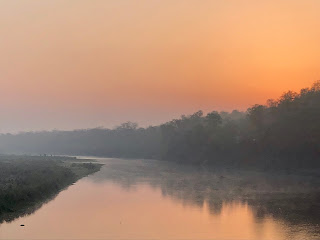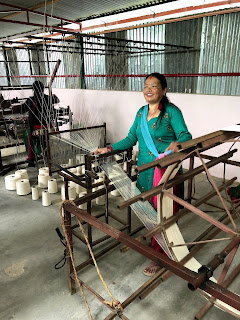Boarding our tiny plane (we were to find smaller, later)
The most adventurous we got off the hotel property that first day was crossing the street to look at the lake. Imagine how much more beautiful this picture would look to someone who had only seen rivers filled with trash for the previous week.

We dedicated our afternoon to a massage and a not-quite-regulation Ayurvedic oil drip, bookended with thrilling meals of boiled vegetables on rice and Clif Bars. Here's what my hair looked like after the oil drip, several shampoos, and a few hours to "dry."

Still saturated with oil
Amanda, amazed
Me, hoping the guide won't say it's time to leave
With Annapurna (L) and Machapuchare (R),
the latter meaning "fishtail"
Time for reflection

And early the next morning we were back on a Buddha Air flight, this one smaller than the last, with only one seat on either side of the aisle, stairs that folded into the cabin and doubled as the door, and an open cockpit.

Oh, hello sirs
We splurged on a resort called Kasara near Chitwan National Park, which had exotic-feeling rooms (check out the entrance to our abode, with the bedroom through a door on the right, and the open-air bathroom and shower through the left), lots of organized adventures in the park, and a pool.


You may imagine we spent most of our time in Chitwan
on safari, but in actuality it was perched right here
on safari, but in actuality it was perched right here

We were in the last suite off of this long, lush path
Early our first morning we climbed into the resort's stadium jeep with several retired couples and headed into the jungle in search of wildlife with our driver and guide.

Sunrise over Chitwan
The jungle is so still until it's not
Had to keep our eyes peeled!
View out the roof
What all will we see?!
We saw a lot: peacocks both flying and dancing, storks, king fishers showing off their bright teal feathers, darter birds with necks like snakes, creepy, greedy little monkeys, and according to Amanda's scrupulous safari notes, the "lesser white something," which I recall as my personal favorite.
The highlight was our search for the greater one-horned rhinoceros. We parked the jeep next to a tall grassland, and kept an eye out for rustling. The guide spotted a rhino, and while at first we could only spot a wiggling ear or hear him marking his territory, eventually he emerged onto the path, casually traipsing over our tracks!
An awed hush befell the group while we took in this
suit-of-armor-clad wonder!
As we contentedly thought that was as good as it would get (barring a miraculous tiger sighting, of course), a mama and her baby came out of the brush, scurrying away from us:
At that point, we felt very satisfied with our safari! Not everyone gets lucky enough to spot rhinos.
A few stories above the thrush where the rhinos grazed
Certainly what Amanda was most looking forward to was visiting Stand Up For Elephants, an NGO providing direct aid, education, and advocacy for and about elephants at Chitwan National Park. There is not a single free elephant in Nepal, as all have been taken into captivity, chained, and used for transportation or tourist attractions under conditions any human worker's union would balk at, not to mention animal rights activists.
SU4E has found an elephant owner that allows them to rent a couple of their calmer elephants to host "elephant happy hours," wherein they have ethically-conscious tourists feed the elephants and wander the jungle with them and their handler, giving the elephants a much-needed break from carrying throngs of tourists on their backs.
Amanda was so excited for this activity that she barely slept and ate before it, elephants being her absolute favorite (spirit?) animal. And when Rupi, our gorgeous new friend emerged, I swear she almost cried. The last time I saw her this aglow had to be her wedding day!

WE FED AN ELEPHANT. She ate all kinds of fruits and vegetables, snaking her trunk around a couple bananas or a squash and curling them up into her mouth whole. As she grabbed the snack, we had the opportunity to pet her trunk, which was absolutely surreal. I was equal parts excited, amazed, and terrified, as she was this majestic creature who could've killed us all at any moment.
But Rupi, whose name means "beauty," was calm and sweet. In just an hour with her, I honestly felt that I got a sense of her personality, and I feel emotionally connected just thinking of her. She loves exploring the jungle freely, which she is only allowed to do during these SU4E hours. You can imagine she's learned to love the people leading the groups and to understand what special privileges are in store for her when they come by with visitors and weighty grocery bags.

Sadly, most elephants in that region never get any sort of breaks like this. Many are chained so tightly that they can't even lie down to sleep. They are washed frequently by handlers whose pride dictates they must have a sparkling clean elephant, even though the dirt protects them from the sun. They get sores under their tails from the platforms attached to their backs to hold riders. The list of injustices goes on an on, each item so unnecessary and heartbreaking.

In a national park, where animal protection is seemingly sacrosanct, elephants just don't make the empathy cut. They have for too long been seen as a financial asset (an elephant often selling for ~$80k in the area), and as a type of transportation mule. Researching this, I found it is estimated that a living elephant brings in almost $1.6 million over its lifetime in ecotourism dollars (via the iWorry campaign by the David Sheldrick Wildlife Trust). They are simply too valuable and too engrained in the economy for the local society to change their minds about them. This mentality is what SU4E hopes to change.
If you're interested in helping their cause, you can donate here!
Rupi engaged in her favorite activity:
scratching up against trees
Can you feel the love tonight?
One last, awe-struck glance
I was so appreciative to Amanda for making sure we were being ecologically conscious on this trip, and as a result I hope to be more thoughtful in future travels. So many tourists are not well-educated (often myself included) about the implications of the attractions they put their money towards, and are just doing it because they're seen it on social media, or its in the tour books of what to do in a certain place. This is a great example of putting your money where your mouth is. If riding elephants wasn't lucrative, it simply wouldn't be the issue it is today.
Last night of vacation vibes
Bird watching, our last adventure before the long journey home, turned out to be a more adventurous undertaking than originally imagined as we alighted from the stadium jeep and received a brief, contrary, and less-than-comforting safety orientation from the guide: "If you see animal, don’t move. I may tell you to run in zig zags."


Nancy, a veritable spirit animal in her own right,
casually holding a deer antler (!)
Along the way Amanda, feeling something was amiss in her shoe, tapped the guide and said simply, "I need your help." She removed the airy sneaker, with Nancy offering stabilization and I photojournalism, and the guide nonchalantly removed a leech from her foot, which had been happily snacking on her for about ten minutes. The guide proceeded to show us the leech by letting it crawl around his hand. Word to the wise: do not google leeches-no good can come from it.
Did we see some beautiful birds? Yes. I even spotted a rare woodpecker for the group and fleetingly felt like a professional naturalist. But what I will remember is Nancy. And the leech. And the terrifying recommendations from the guide about what I should do if we encounter a rhino. But yes, the birds were nice, too. Even the ones we only pretended to see.






















































